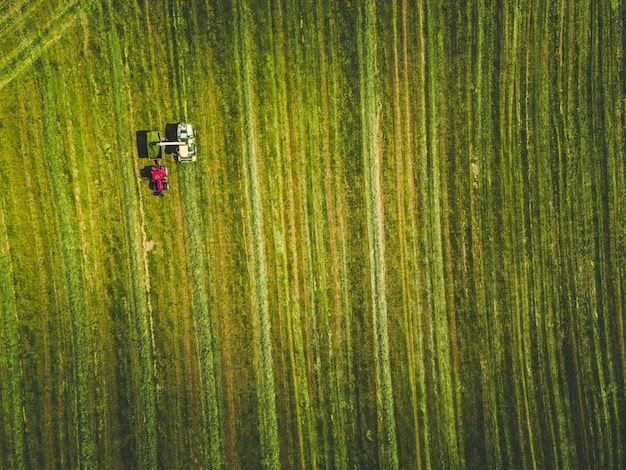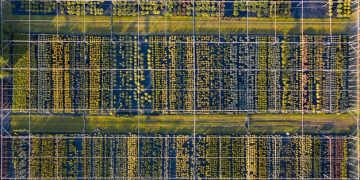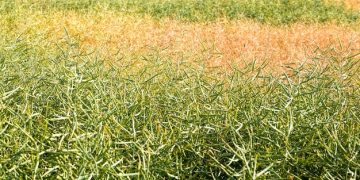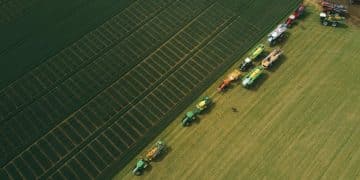AI Soil Analysis: Boost Crop Yields by 15% in 2025

AI-powered soil analysis offers precision insights into soil health, enabling farmers to optimize nutrient management, reduce waste, and potentially increase crop yields by 15% by 2025 through data-driven decision-making.
Are you ready to revolutionize your farming practices and increase crop yields by 15% in 2025? With the advent of AI-powered soil analysis, a new era of precision agriculture is dawning.
Understanding AI-Powered Soil Analysis
AI-powered soil analysis is transforming how farmers understand and manage their land. By leveraging artificial intelligence, this technology provides detailed insights into soil composition, nutrient levels, and potential issues affecting crop health. This section explores the basics of this innovative approach.
The Basics of Soil Analysis
Traditional soil analysis methods are time-consuming and often lack the precision needed for optimal crop management. In contrast, AI-powered systems use advanced sensors and machine learning algorithms to deliver real-time data and actionable recommendations.
How AI Enhances Traditional Methods
AI enhances traditional soil analysis by automating data collection, improving accuracy, and providing predictive analytics. This leads to more informed decision-making and better resource utilization.
- Improved Accuracy: AI algorithms reduce human error and provide more consistent results.
- Real-Time Data: Farmers receive immediate feedback, allowing for timely interventions.
- Predictive Analysis: AI can forecast potential issues, such as nutrient deficiencies or disease outbreaks.
AI-powered soil analysis offers a significant upgrade over traditional methods, providing farmers with the tools they need to optimize their operations and increase crop yields.

Benefits of Implementing AI in Soil Management
Implementing AI in soil management offers a multitude of benefits, from optimizing resource allocation to reducing environmental impact. This section delves into the specific advantages that farmers can expect.
Increased Efficiency and Reduced Costs
AI-powered systems can significantly reduce costs by optimizing the use of fertilizers, water, and other resources. By applying these inputs only where and when they are needed, farmers can minimize waste and maximize efficiency.
Environmental Benefits
Precision agriculture, enabled by AI, reduces the environmental impact of farming. This includes decreasing the use of harmful chemicals and minimizing soil erosion.
- Reduced Fertilizer Use: AI helps farmers apply fertilizer more precisely, reducing runoff and pollution.
- Water Conservation: Smart irrigation systems optimize water usage based on real-time soil moisture data.
- Soil Health: AI assists in maintaining soil health, preventing erosion and promoting biodiversity.
By embracing AI in soil management, farmers can achieve both economic and environmental benefits, leading to more sustainable and profitable operations and helping increase crop yields by 15%.
Key Components of AI Soil Analysis Systems
Understanding the key components of AI soil analysis systems is crucial for farmers looking to adopt this technology. This section outlines the essential elements that make up these advanced systems.
Sensors and Data Collection
The foundation of any AI soil analysis system is the network of sensors used to collect data. These sensors can measure a wide range of parameters, including nutrient levels, moisture content, and pH levels.
Data Processing and Machine Learning
Collected data is processed using machine learning algorithms to identify patterns and trends. These algorithms can predict future soil conditions and recommend optimal management practices.
- Data Analytics: AI algorithms analyze soil data to provide insights into crop health and yield potential.
- Machine Learning Models: These models continuously learn from new data, improving their accuracy over time.
- Cloud Computing: Data is stored and processed in the cloud, allowing for easy access and scalability.
These key components work together to provide farmers with a comprehensive and actionable understanding of their soil, enabling them to increase crop yields and improve overall farm management using AI-powered soil analysis.

Preparing Your Farm for AI Soil Analysis in 2025
To fully leverage the potential of AI soil analysis in 2025, farmers need to prepare their farms by investing in the necessary technology and infrastructure. This section offers guidance on how to get started.
Assessing Your Current Infrastructure
Before implementing AI-powered systems, farmers should assess their existing infrastructure, including internet connectivity and data storage capabilities. Upgrades may be necessary to support the new technology.
Training and Education
Farmers and their staff will need training to effectively use AI soil analysis systems. This includes understanding how to interpret data and implement recommended practices.
- Workshops and Seminars: Attend industry events to learn about the latest advancements in AI agriculture.
- Online Courses: Enroll in online courses to gain a deeper understanding of AI and data analytics.
- Consulting Services: Hire experts to provide personalized training and support.
By preparing their farms and investing in training, farmers can seamlessly integrate AI soil analysis into their operations and reap the full benefits of this technology and increase crop yields by 15%.
Potential Challenges and How to Overcome Them
While AI soil analysis offers numerous benefits, farmers may encounter challenges during implementation. This section addresses common issues and provides strategies to overcome them.
Data Privacy and Security
Protecting data privacy and security is crucial when using AI-powered systems. Farmers should ensure that their data is stored and processed securely, and that they comply with all relevant regulations.
Initial Investment Costs
The initial investment in AI soil analysis technology can be significant. However, farmers can mitigate this cost by exploring financing options and focusing on long-term ROI.
- Government Grants: Research and apply for government grants that support the adoption of precision agriculture technologies.
- Leasing Options: Consider leasing equipment to reduce upfront costs.
- Phased Implementation: Implement AI soil analysis in phases, starting with the most critical areas of your farm.
By addressing these challenges proactively, farmers can successfully implement AI soil analysis and unlock its full potential to help **increase crop yields**.
The Future of Farming: AI and Sustainable Agriculture
The integration of AI into agriculture is set to revolutionize the industry, paving the way for more sustainable and efficient farming practices. This section explores the future of farming with AI.
Advancements in AI Technology
Ongoing advancements in AI technology are expected to further enhance the capabilities of soil analysis systems. This includes the development of more sophisticated algorithms and the integration of additional data sources.
Policy and Support
Government policies and industry support play a crucial role in promoting the adoption of AI in agriculture. Initiatives that encourage research, development, and training can help accelerate the transition to AI-driven farming.
- Incentives: Governments can offer tax incentives and subsidies to encourage farmers to adopt AI technologies.
- Research Funding: Increased funding for research and development can lead to breakthroughs in AI agriculture.
- Education Programs: Supporting education programs can help train the next generation of AI-savvy farmers.
The future of farming is inextricably linked to AI, with AI soil analysis systems playing a vital role in creating a more sustainable and productive agricultural sector and helping increase crop yields by 15%.
| Key Aspect | Brief Description |
|---|---|
| 🌱 Soil Analysis | AI-powered systems accurately assess soil composition. |
| 💰 Cost Reduction | Optimize resource use, reducing waste and expenses. |
| 🌿 Sustainability | Minimize environmental impact with precision agriculture. |
| 📈 Yield Increase | AI-powered soil analysis can potentially increase crop yields by 15% by 2025. |
Frequently Asked Questions
▼
AI-powered soil analysis uses artificial intelligence to assess soil composition, nutrient levels, and other factors influencing crop health, providing farmers with actionable insights for better management.
▼
AI can increase crop yields by optimizing resource allocation, providing precise nutrient recommendations, and predicting potential issues before they impact crop health, leading to better overall management.
▼
The main benefits include increased efficiency, reduced costs through optimized resource use, environmental benefits from decreased chemical use, and improved crop yields due to better soil management.
▼
The initial investment can be significant, but farmers can mitigate costs by exploring financing options, government grants, and phased implementation strategies to make it more affordable.
▼
Assess your current infrastructure, invest in necessary technology, and provide training for your staff to effectively interpret data and implement recommended practices for seamless integration of AI.
Conclusion
By embracing AI-powered soil analysis, farmers can unlock the full potential of their land, optimize resource use, and significantly increase crop yields by 15% in 2025, paving the way for a more sustainable and profitable future for agriculture.





